I have been studying the shoulder, and have taken what I have learned and put together a short basic article about the shoulder.
The Shoulder
The shoulder is the most complex and most flexible of the body’s joints. The shoulder joint is what allows us to use and move our arms and, as a result, move our hands. To be so flexible, the shoulder must have a wide range of movement. Unfortunately, this makes the shoulder joint one of the less stable joints in the body, and is prone to injury. Let’s take a look at the shoulder; we will start with the bones.
Shoulder Bones:
The shoulder joint includes 3 bones: the clavicle (collarbone), the scapula (shoulder blade), and the humerus (upper arm bone), with two joints. These joints are the acromioclavicular (AC) joint and the glenohumeral joint (GH) which is the traditional "ball-and-socket" that allows complete range of motion.
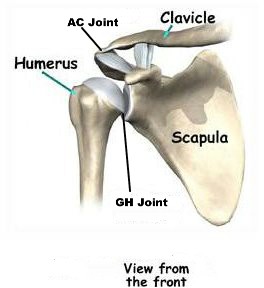
Look at the GH joint, it is not truly a ball and socket joint at all. Let’s take a look at what really holds this joint together.
Rotator Cuff:
Your rotator cuff is made up of the muscles and tendons in your shoulder. Four major muscles (subscapularis, supraspinatus, infraspinatus and teres minor) and their tendons connect your upper arm bone (humerus) with your shoulder blade. They also help hold the ball of your upper arm bone firmly in your shoulder socket, as if holding a golf ball on a tee. The combination results in the greatest range of motion of any joint in your body.
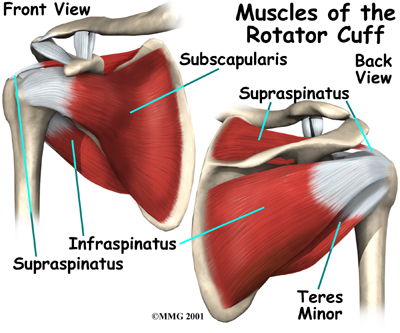
I wanted to explain a bit about the Bicep Tendons. Tendons are extensions of muscles that attach muscles to bone. Muscles move the bones by pulling on the tendons. The biceps muscle has two tendons at the shoulder, called the Long Head and Short Head.
The Long Head of Biceps is a very important tendon that travels through the shoulder joint (glenohumeral joint).The biceps tendon begins at the top of the shoulder socket and then passes across the front of the shoulder to connect to the biceps muscle. It is easy to see now how someone with a torn bicep tendon has pain in their shoulder.
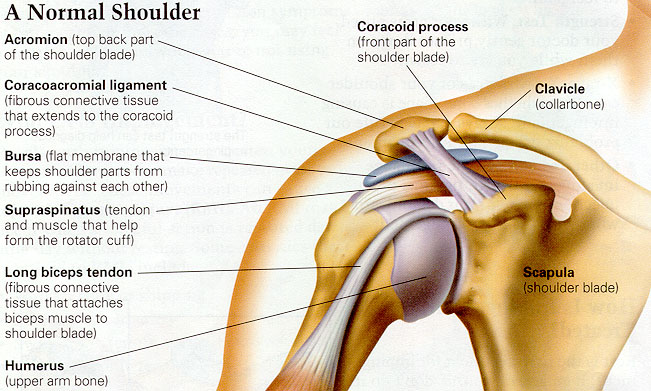
Other Muscles:
There are 30 muscles providing movement and support for the shoulder complex. 15 muscles move and stabilize the scapula; 9 muscles provide for glenohumeral joint motion;and 6 support the scapula on the thorax. Here are a few muscles of the shoulder.
1. Surface Front Muscles (Anterior):
- The large deltoidmuscle forms the outer layer of muscle. This is the largest, strongest muscle of the shoulder. The deltoid muscle takes over lifting the arm once the arm is away from the side.
- Pectoralis Major provides movement and support in the front of the shoulder
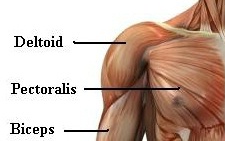
2. Surface Back Muscles (Posterior):
These muscles are at the back of the shoulder that stabilise and move the scapula on the trunk of the body. This group includes the trapezius, rhomboids, levator scapulae, and the serratus anterior muscles; and are concerned with stabilisation and rotation of the scapula.(not all muscles in photo)
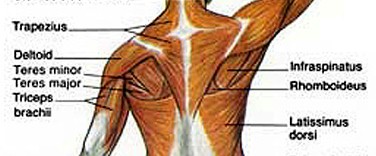
Shoulder Problems
Arthritis
Beginning as early as age 50, some people develop osteoarthritis, which causes painful movement. This occurs as the smooth surfaces of the cartilage that line the bones of the shoulder joint are worn away, and joints begin to wear out. The most common cause of osteoarthritis is overuse. Treatments for arthritis in the shoulder depend on the severity of pain. The usual treatments are rest, and cortisone injections. In some instances, a replacement of the shoulder joint is necessary.
Overuse/strains
Sudden increases in activity can place extensive stress on the shoulders and lead to a decrease in flexibility. This is a common problem in middle age, especially among "weekend warriors," or people who don't exercise regularly but go out every now and then for an intense sport. Although painful and inconvenient, these overuse problems can usually be treated with rest, and stretching exercises.
Popping or Clicking
Popping or clicking in the shoulder can be related to many causes. Sometimes it is caused by a cartilage tear or rotator cuff tear that is rubbing within the joint. Other times, it can be due to subtle instability, or the shoulder is coming in and out of socket.
Stiffness
Stiffness can be caused by many problems in the shoulder. Often, pain from a rotator cuff injury will force you to stop using your shoulder; then the shoulder gets stiff because of a build up of scar tissue. This is often called a frozen shoulder. Stiffness can also be caused by arthritis of the shoulder. Sometimes, especially in diabetics, shoulder stiffness can set in for no reason. This is called adhesive capsulitis.
Looseness
Looseness is often a sign of shoulder instability. That is, if you feel your shoulder is coming in and out of the socket, or especially if you have dislocations and need to go to the ER to get the shoulder put back in place, then you have shoulder instability by definition.
Exercise
There are so many exercises, and ways to stretch, I would suggest that you consult your doctor or physical therapist when starting up an exercise program after experiencing pain or an injury. When ever you experience pain while exercising, stop! If the pain continues, see your doctor as soon as you can to diagnose the problem and get you on the road to recovery.
When exercising, be aware of your posture, position, and form. Listen to your body and follow common sense. When working out with friends, be careful to stay within your limits, don’t try something new just to show off, you may not be ready for it and get injured. An injury is the last thing you want to have. I have been nursing a shoulder injury for a year now and I had to give up many things that I enjoyed doing; playing tennis, cycling, boxing, just to name a few. As I tell all of my clients, when exercising be aware of your joints at all times, follow a well balanced exercise program, and never work through pain.
 | 









